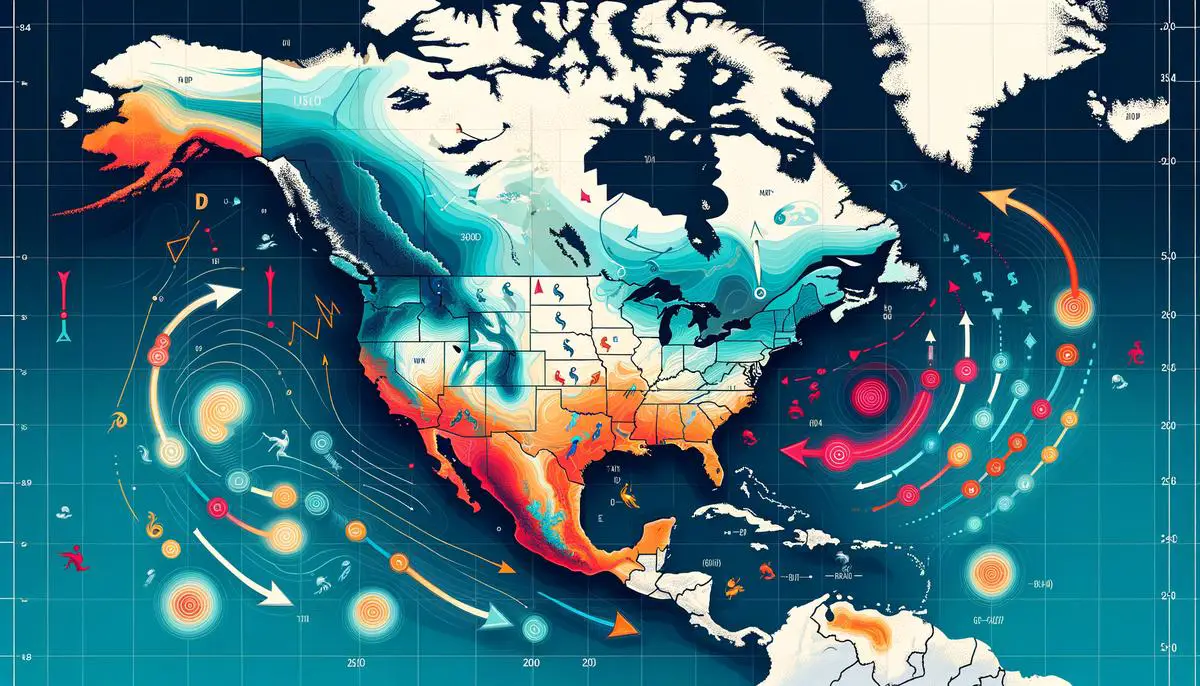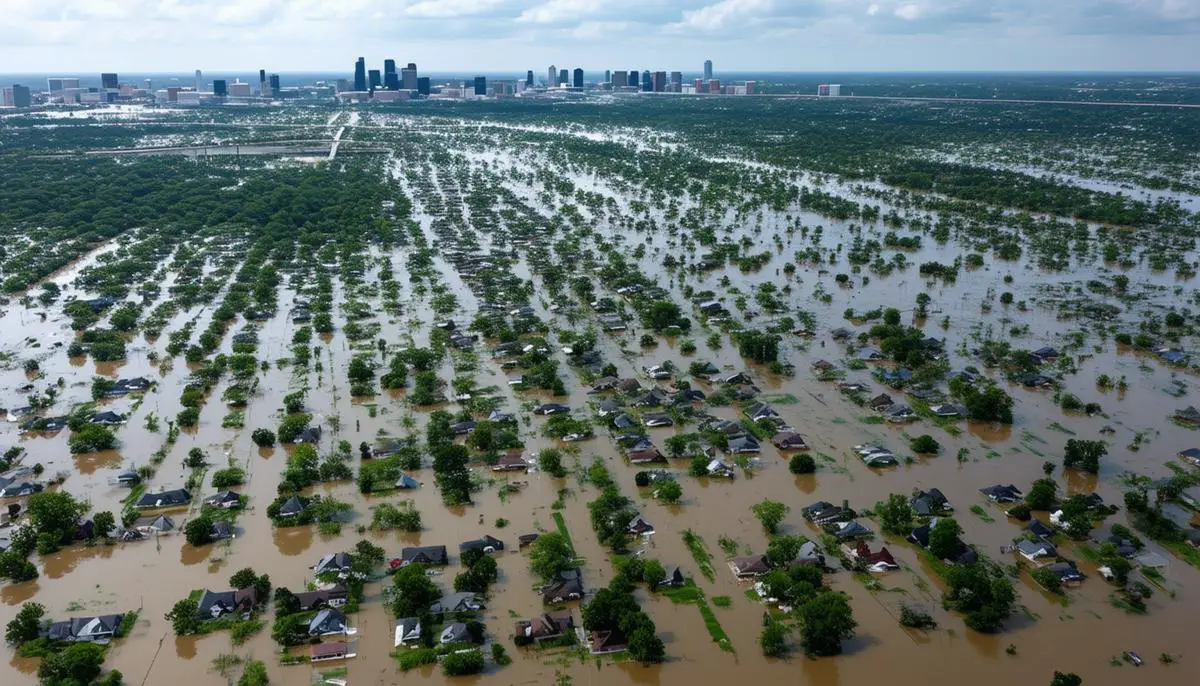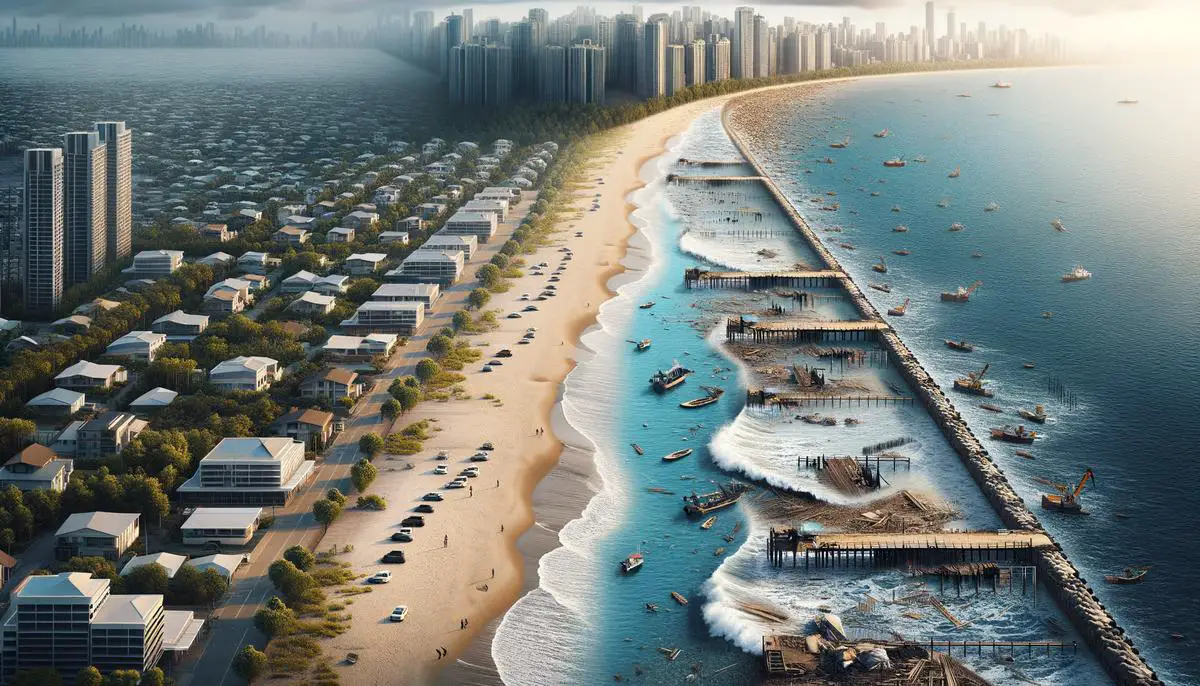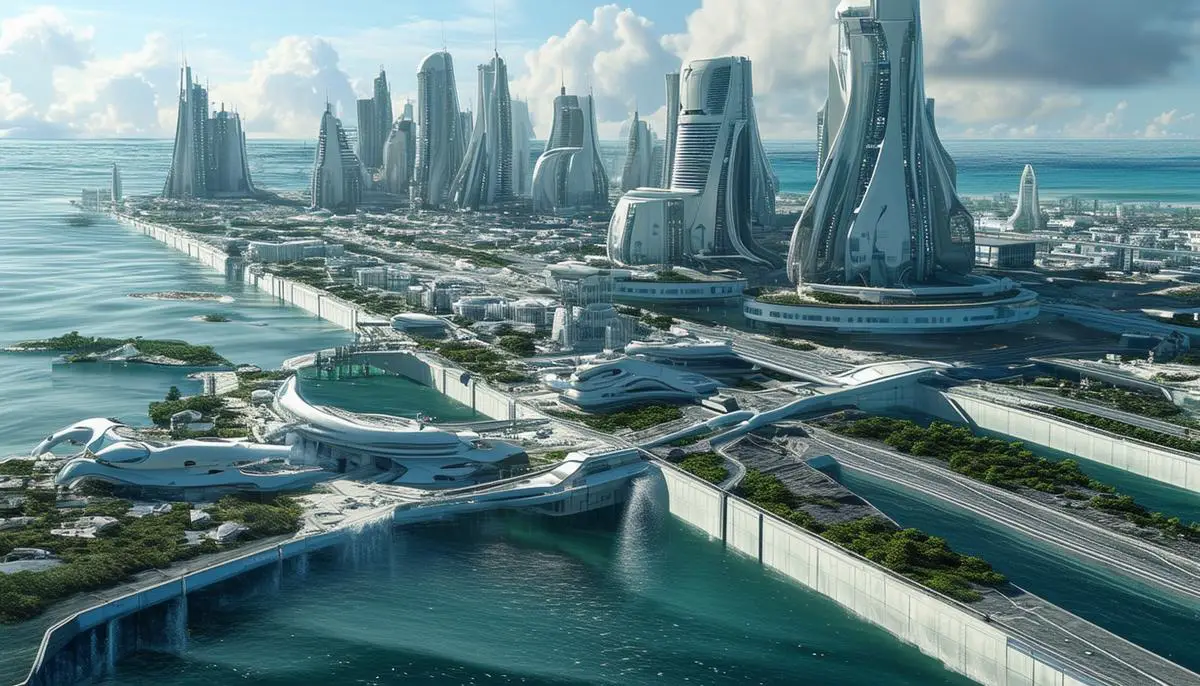Climate change is reshaping the characteristics of hurricanes, making them more intense and unpredictable. Rising sea surface temperatures are a significant factor, fueling these storms with more energy and resulting in higher wind speeds and increased rainfall. As we observe these changes, it becomes crucial to understand their implications on our communities and infrastructure.
Impact of Climate Change on Hurricane Intensity
Rising sea surface temperatures are intensifying hurricanes' destructive power. Warm ocean waters provide more energy, resulting in higher wind speeds. Since the 1980s, scientists have observed a marked increase in hurricane intensity, with a notable rise in Category 4 and 5 storms.
Dr. Alex Hall from UCLA notes that hurricanes require warm oceans to form. Climate change is extending the traditional hurricane season, with more potent storms occurring earlier, such as Hurricane Beryl becoming the earliest Category 5 hurricane on record.
NOAA reports that warmer waters are leading to increased hurricane rainfall. Tropical cyclones now produce 10-15% more precipitation than they would in a cooler climate. Hurricane Harvey in 2017 exemplified this trend, dropping over 60 inches of rain in some areas and causing catastrophic flooding.1
Key Impacts of Climate Change on Hurricanes:
- Increased storm surge due to rising sea levels
- Higher wind speeds and more Category 4 and 5 storms
- Extended hurricane seasons
- More intense rainfall and flooding
- Slower-moving hurricanes causing prolonged damage
The warming atmosphere retains more water vapor, providing additional fuel for hurricanes and leading to intense rainfall and flooding. Climate change may also be altering tropical cyclone paths, with evidence suggesting that hurricanes are reaching peak intensity further north.
The financial costs of hurricanes are rising, with four of the ten costliest U.S. hurricanes occurring in 2017 and 2018. Hurricane Katrina remains the most expensive, with $186 billion in damages.
The Power Dissipation Index (PDI) shows a noticeable increase in cyclone intensity since 1995, mirroring the rise in sea surface temperatures. Hurricanes are not only becoming stronger but are intensifying more rapidly, giving communities less time to prepare or evacuate.
"Many stormwater systems were designed for a different climate and are often overwhelmed by current conditions." – Dr. Steve Vavrus, Wisconsin State Climatology Office
To address these challenges, communities must rethink their infrastructure and preparedness strategies. Reducing greenhouse gas emissions is crucial to slowing these harmful trends. Further warming will only exacerbate storm behaviors, potentially making future hurricane seasons even more devastating.

Changes in Hurricane Frequency and Patterns
While hurricane intensity has increased, changes in frequency and patterns are more nuanced. Historically, the Atlantic Ocean has seen around six to seven hurricanes annually since 1878, with two making landfall in the United States each year. Recent decades have sparked debates among scientists about changes in hurricane behavior.
When examining historical data and adjusting for advances in observation techniques, there's no clear long-term increase in the overall number of Atlantic hurricanes. However, the propensity for extreme storms has risen significantly.
Studies in the Pacific indicate a northward migration of tropical cyclones' peak intensity. While the Atlantic hasn't mirrored this northward shift as distinctly, the possibility remains a concern for coastal communities further north.
Recent Changes in Hurricane Patterns:
- Shift in hurricane season timing
- Potential decrease in total tropical storms globally
- Increase in the most intense hurricanes
- Slower storm progression leading to prolonged impacts
Climate change has also altered hurricane season timing. Hurricane Beryl, the earliest recorded Category 5 hurricane, underscored this shift. NOAA has revised its forecast to an above-average season, predicting between 14 and 21 named storms, reflecting the increased variability introduced by climate change.2
Future projections suggest a decrease in total tropical storms globally but an uptick in the most intense hurricanes. This counterintuitive outlook results from more powerful storms fueled by warmer waters, even if fewer in number.
The observed slowing of storm progression adds another layer of complexity. Slow-moving storms, like hurricanes Harvey and Dorian, can unleash relentless rain and winds on a single area, causing extensive flooding and damage.
Historical records need to be interpreted carefully due to observational biases, especially before the advent of satellite tracking and aerial reconnaissance. Despite this, indices like the Power Dissipation Index (PDI) and the Accumulated Cyclone Energy (ACE) Index point to an increase in the destructive potential of storms since the mid-1990s, correlating with rising sea surface temperatures.
These changes require a paradigm shift in how communities prepare for, respond to, and build resilience against hurricanes. Improved forecasting, better infrastructure, and comprehensive strategies to mitigate the looming threats posed by extreme weather events are essential.
Reducing greenhouse gas emissions remains critical to managing these shifts in hurricane patterns. As we grapple with the changes already set in motion, it's crucial to commit to policies and actions that will safeguard our communities for the future.

Increased Rainfall and Flooding
Hurricanes today are producing more rainfall than ever before, directly linked to our warming planet. As the atmosphere heats up, it can hold more moisture, leading to heavier rainfall during hurricanes. This change translates to more intense rainstorms, highlighting the impact of climate change on our weather patterns.
Hurricane Harvey in 2017 exemplified this trend, lingering over Houston and unleashing more than 60 inches of rain in some locations. Scientists estimate that Harvey's rainfall was intensified by at least 18% due to climate change, adding nearly two feet of additional water to an already overwhelmed city.3
Impacts of Increased Hurricane Rainfall:
- Overwhelmed stormwater systems and drainage infrastructure
- Widespread flooding and significant property damage
- Water contamination and increased risks of waterborne diseases
- Long-term economic repercussions for affected communities
This increase in rainfall strains our infrastructure to its limits. Many stormwater systems and drainage setups were designed based on historical climate data, which didn't account for the heightened levels of precipitation linked to modern climate trends. As Vavrus from the Wisconsin State Climatology Office points out, much of this infrastructure isn't prepared for these heavier rains, leading to widespread flooding and significant damage.
Compounding these issues is the reality of changing storm behavior. Slow-moving hurricanes, like Dorian in 2019, can pour relentless rain for extended periods, exacerbating flood risks. These stationary tempests vividly illustrate the vulnerabilities in our urban planning and disaster readiness strategies.
Innovative Solutions for Managing Increased Rainfall:
- Updating drainage systems
- Investing in green infrastructure (permeable pavements, rain gardens)
- Expanding wetlands and natural buffers
- Enhancing emergency preparedness plans
- Enforcing stricter building codes for flood resistance
Communities need innovative solutions to manage this deluge of rainfall. Beyond updating drainage systems, investing in green infrastructure like permeable pavements, rain gardens, and expanded wetlands can help absorb excess water. Replenishing natural buffers such as marshlands and forests also plays a critical role in mitigating floods.
While addressing immediate concerns, it's essential to confront the root cause—global emissions. Reducing greenhouse gases is imperative to curbing future climate impact. This shift involves major policy changes, technological advancements, and individual commitments to more sustainable living.
The rainier, more destructive hurricanes underscore the urgency of these actions. They push us to reimagine our relationship with the environment, nudging us towards a future where sustainability and resilience are integral to our societies. In a world where severe storms can no longer be seen as anomalies, the goal must be to adapt while fervently working to mitigate their drivers.

Sea Level Rise and Coastal Impact
Sea level rise exacerbates hurricane damage, intensifying storm surges that coastal communities endure. Regional variations and historical data show coastal flooding is becoming more frequent and severe. The encroachment of rising seas, accelerated by climate change, amplifies hurricane impacts—putting lives, homes, and businesses at greater risk.
Hurricane Katrina in 2005 demonstrates this effect. New Orleans faced catastrophic flooding, partly due to storm surge combined with elevated sea levels. Research shows that flood heights during Katrina were 15-60% higher than they might have been a century ago, pre-climate change. This increase highlights how rising seas can magnify natural disasters.
Hurricane Sandy in 2012 brought devastation to the Northeastern U.S. The storm's surge inundated New York City and parts of New Jersey, causing billions in damages. Estimates suggest the probability of such extreme flooding events has doubled due to human-induced climate change. Sea level rise made Sandy's surge more potent, compounding the flooding and heightening its destructive reach.
In 2023, Hurricane Idalia slammed into Florida, driving significant storm surge onto already vulnerable coastlines. Places that had never seen such flooding before found themselves underwater. Residents and authorities were taken aback by the extent and rapid escalation of the flooding.
Infrastructure Vulnerability
Hurricanes impact more than just coastal properties. Infrastructure upon which cities and towns rely—electric grids, water systems, and transportation networks—are acutely vulnerable to storm surge and flooding. In Puerto Rico, Hurricane Maria in 2017 caused overwhelming damage, including a complete power grid collapse. Electricity remained scarce for months, and clean water sources were disrupted, exposing citizens to health hazards long after the storm had passed.
Rising sea levels also destabilize natural coastal barriers. Wetlands, coral reefs, and barrier islands, which traditionally act as buffers against storm surge and erosion, are themselves at risk. As these natural defenses erode or submerge, their ability to protect inland areas diminishes, leaving cities and towns more exposed.
Adaptation Strategies
- Implementing strong coastal zoning laws
- Retrofitting existing buildings
- Constructing levees
- Preserving and restoring natural barriers
- Enhancing early warning systems
- Incorporating resilience into infrastructure designs
To address the underlying issue, there's an urgent need for global cooperation in reducing greenhouse gas emissions. As rising seas and stronger storms become the norm, a shift towards sustainable energy sources and reduced carbon footprints is imperative. Developing countries, which often bear the brunt of climate impacts, need support from wealthier nations to build resilience and transition to sustainable practices.
How can we balance the need for coastal development with the increasing risks posed by sea level rise? What role can individuals play in supporting community-level adaptation efforts?

Future Projections and Preparedness
Scientists project that while the overall number of tropical cyclones may not increase significantly, their intensity will. This creates a scenario where fewer hurricanes could potentially cause far more damage, exerting massive pressures on communities and economies alike.
Climate models anticipate enhanced storm intensity fueled by warmer sea surface temperatures. Hurricanes are expected to reach higher maximum wind speeds, increasing their destructive potential. The likelihood of Category 4 and 5 hurricanes has increased substantially. The Accumulated Cyclone Energy (ACE) Index and the Power Dissipation Index (PDI) show a steep rise over the past few decades, aligning closely with rising global temperatures1.
The projected increase in hurricane-associated rainfall adds to the problem. As the atmosphere continues to warm, it will retain more moisture, resulting in more intense and sustained precipitation during hurricanes. This enhanced rainfall risk necessitates substantial improvements in stormwater management systems.
While the overall count of tropical cyclones might see a slight downturn, the frequency at which these storms reach severe categories is expected to rise. Existing data and models indicate that the proportion of Category 4 and 5 hurricanes will climb steadily with continued global warming2.
Multi-faceted Approach to Address Threats
- Infrastructure fortification: Upgrading stormwater systems to handle new precipitation norms and reinforcing power grids and communication networks.
- Land-use planning: Implementing strict building codes that require flood-resistant designs and promoting the relocation of residents from high-risk zones through managed retreat and buyout programs.
- Natural defenses: Preserving and restoring wetlands, dunes, and reefs to act as natural buffers against approaching storms.
- Technology and information dissemination: Enhancing forecasting and real-time monitoring systems for early warnings, and developing community-focused education initiatives on emergency preparedness.
- Mitigation and adaptation balance: Reducing greenhouse gas emissions through policy changes, technological breakthroughs, and individual commitments to sustainable living.
The stakes are high, as future hurricane projections suggest more intense, rainier, and potentially destructive storms. The call to action is clear: reducing emissions and implementing resilient infrastructure are immediately necessary to mitigate these looming threats.
How can communities effectively balance short-term economic interests with long-term resilience planning? What innovative solutions could help bridge the gap between current preparedness levels and future hurricane threats?

The escalating intensity and unpredictability of hurricanes underscore the urgent need for comprehensive preparedness and mitigation strategies. By addressing the root causes and adapting our infrastructure, we can better protect our communities from the devastating impacts of these powerful storms. The time to act is now, as the future of hurricane activity demands proactive measures to safeguard lives and property.
![]()
